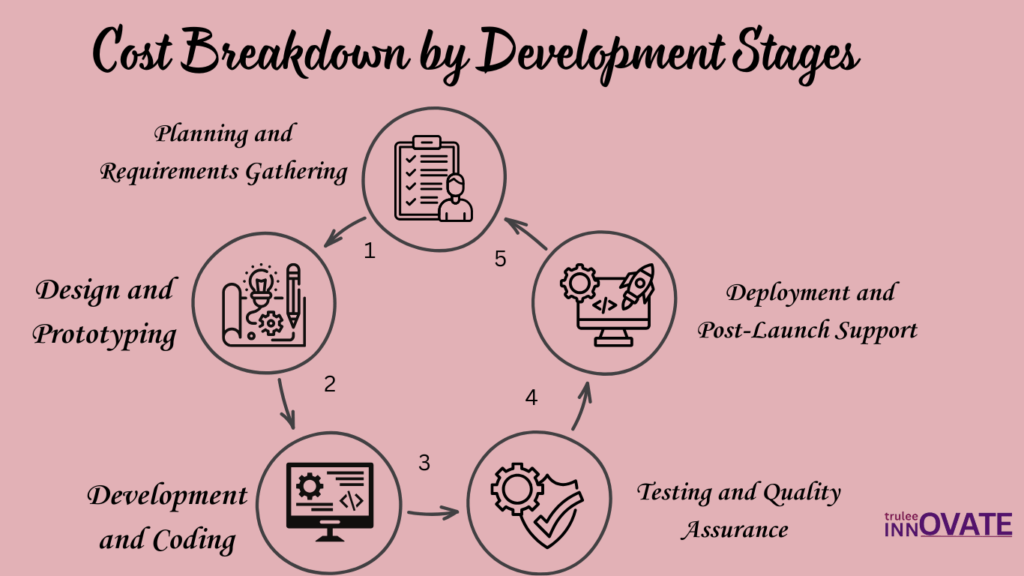Introduction: Why Understanding the Costs of Software Development is Crucial
Software development is no longer a luxury; it’s a necessity for businesses of all sizes aiming to stay competitive in a tech-driven world. Whether it’s a mobile app, a website, or a custom enterprise solution, understanding the costs of software development is essential for planning and budgeting effectively. However, estimating these costs can be challenging due to numerous influencing factors, from the type of project to the development methodology used. This blog aims to break down the major components, hidden expenses, and actionable strategies to optimize software development costs while achieving your goals.
Key Factors Influencing the Costs of Software Development
1. Project Complexity and Scope
The complexity and scope of a project directly influence the overall development costs.
- Small Projects: These typically include basic websites or applications with limited functionality. They require less time and fewer resources, making them relatively cost-effective.
- Medium Projects: Examples include e-commerce websites or mobile apps with moderate customization and integration needs. These projects are more expensive due to additional features like payment gateways, APIs, and user authentication.
- Large Projects: Enterprise-level applications with complex functionalities, such as machine learning, data analytics, or multi-user systems, require a significant investment. These projects often involve long-term development and maintenance, contributing to higher costs.
The more complex and feature-rich the project, the more hours developers and designers need to dedicate, increasing the costs of software development.
2. Custom vs. Off-the-Shelf Solutions
Another critical factor is whether you opt for custom-built software or off-the-shelf solutions.
- Custom Software Development: Tailored to your specific business needs, custom software offers unique features and scalability. However, it comes with higher upfront costs due to design, development, and testing from scratch.
- Off-the-Shelf Solutions: Pre-built software solutions are generally cheaper and faster to implement but may lack the flexibility and scalability needed for long-term growth. Additionally, recurring licensing fees and limited customization can add to the total cost over time.
Deciding between the two depends on your business requirements, long-term goals, and budget.
3. Development Team Location and Expertise
The geographical location and skill level of your development team can significantly impact your costs.
- Onshore Teams: These teams operate in your home country and provide high-quality services, but they are typically the most expensive option due to higher salaries and living costs.
- Offshore Teams: Hiring developers from countries with lower labor costs (e.g., India, Eastern Europe) can be a budget-friendly option. However, challenges like time zone differences and cultural barriers can affect communication and efficiency.
- Hybrid Teams: A combination of onshore and offshore resources allows businesses to balance quality and cost. For instance, critical tasks may be handled by onshore experts, while routine coding is outsourced to offshore teams.
Additionally, experienced developers often charge higher rates, but their expertise can save time and reduce errors, ultimately making the project more cost-effective.
Hidden Costs in Software Development You Might Overlook
- Maintenance and Updates
Launching software is only the beginning. Regular maintenance is essential for fixing bugs, enhancing security, and ensuring compatibility with new technologies. These ongoing costs can sometimes exceed the initial development budget. - Scaling and Performance Enhancements
As your user base grows, your software may need to scale to accommodate higher traffic or additional features. This requires further development and infrastructure investments, increasing the costs of software development over time. - Licensing and Third-Party Tools
Many software projects rely on third-party libraries, APIs, and tools, which may involve recurring licensing fees. While these tools can accelerate development, their cumulative costs can add up, especially for larger projects.
How Different Development Models Impact Costs
1. In-House Development
Building an in-house team gives you complete control over the project. However, the costs of salaries, benefits, office space, and equipment can make this the most expensive option.
2. Outsourcing vs. Freelancers
- Outsourcing: Partnering with a development agency ensures quality and accountability, but it often comes at a premium.
- Freelancers: A cost-effective alternative, freelancers can handle smaller projects or specific tasks. However, the lack of oversight and consistency can pose challenges for larger projects.
3. Hybrid Development Teams
Combining in-house and outsourced resources offers flexibility and cost-efficiency. For example, you can manage core functionalities in-house while outsourcing less critical tasks to external teams.
Cost Breakdown by Development Stages
1. Planning and Requirements Gathering
This initial phase involves defining the project scope, target audience, and key features. Investing in detailed planning can prevent costly changes and delays later in the development process.
2. Design and Prototyping
Designing user interfaces and creating prototypes ensure that the final product meets user expectations. This phase is crucial for usability but can be resource-intensive, depending on the complexity of the design.
3. Development and Coding
This is the core phase where developers write the code. The costs depend on factors like the programming language, development platform, and the size of the team.
4. Testing and Quality Assurance
Testing is vital for identifying bugs and ensuring a seamless user experience. Automated testing tools can reduce time and costs compared to manual testing methods.
5. Deployment and Post-Launch Support
Deploying the software and providing ongoing support are critical for long-term success. Costs in this phase include server hosting, monitoring, and user feedback integration.

Strategies to Manage and Optimize the Costs of Software Development
1. Clear Requirement Definition
Clearly defining your requirements helps prevent scope creep, which can lead to unanticipated expenses.
2. Agile Methodology and Iterative Development
Agile development practices allow for flexibility and continuous improvement, reducing the risk of costly errors.
3. Investing in the Right Tools and Technologies
Choosing cost-effective tools and technologies that align with your project needs can significantly reduce development time and expenses.
Case Studies: Cost Variations Across Different Types of Software Projects
- E-Commerce Platforms: Higher costs due to payment gateways, inventory management, and user-friendly design.
- Mobile Apps: Costs depend on platform (iOS vs. Android) and additional features like GPS or push notifications.
- Enterprise Solutions: Require substantial investment due to complex functionalities and large-scale deployment.
Future Trends That May Influence the Costs of Software Development
- AI and Machine Learning Integration: Advanced technologies increase upfront costs but offer long-term benefits.
- Blockchain-Based Applications: These are highly secure but require specialized expertise, adding to development costs.
- Low-Code and No-Code Platforms: These platforms reduce development time and costs for simpler projects.
Conclusion: Striking the Right Balance Between Quality and Cost
Understanding the costs of software development is essential for successful project execution. By considering key factors, planning strategically, and leveraging cost-saving practices, businesses can achieve high-quality software solutions without exceeding their budgets.


